Easy homemade almond milk is one of the best dairy alternatives and it’s healthier and less expensive than store-bought! Try other dairy-free kinds of milk like peanut milk and homemade coconut milk.
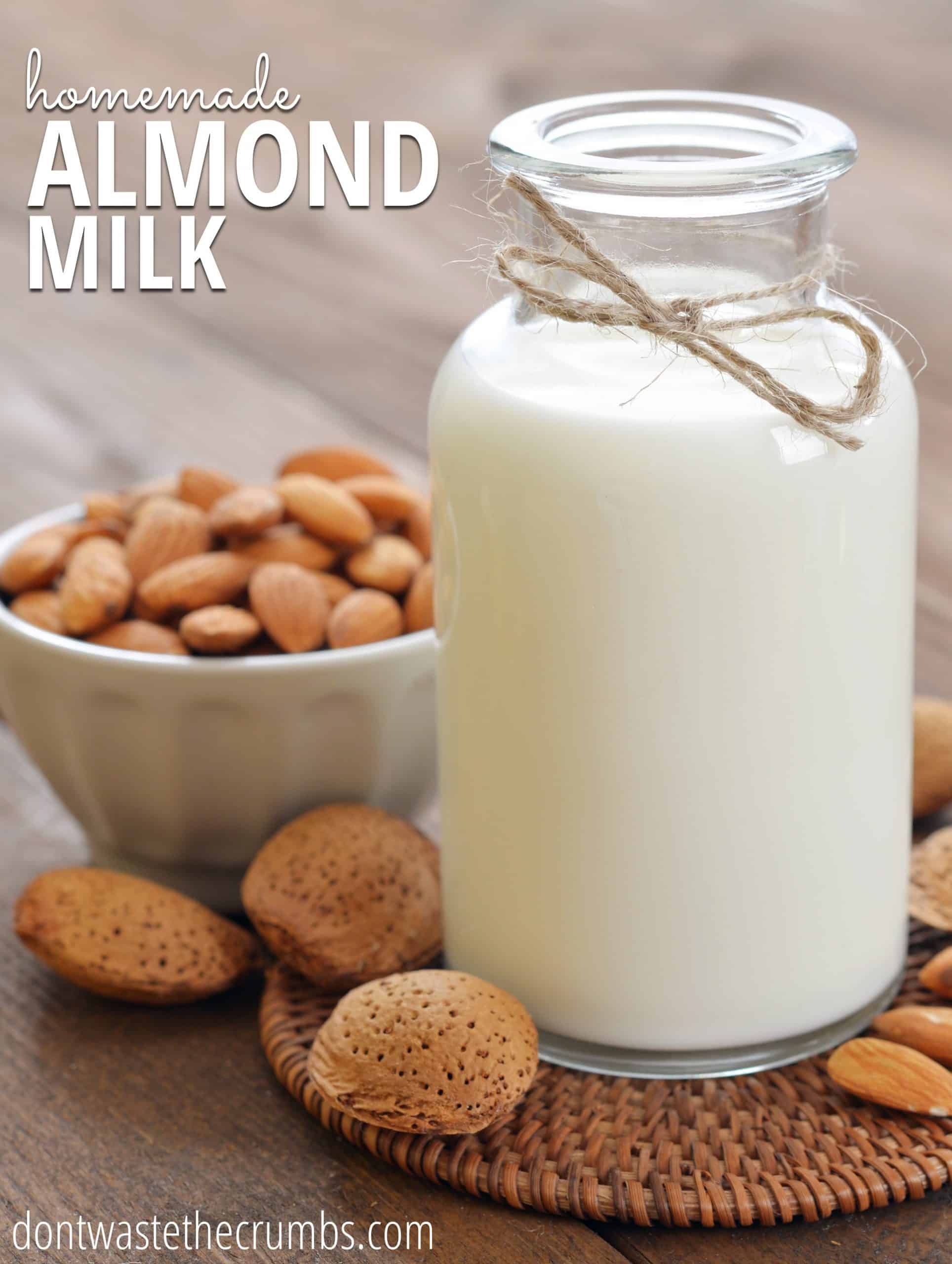
It’s official – almond milk is now the #1 preferred alternative to non-dairy milks. A title that soy milk used to have bragging rights to now goes to America’s second favorite nut.
What’s a good thing for the almond industry could also be a good thing for consumers since 93% of soybeans in the United States are genetically modified. A scary, and sobering thought to consider too is that the soy milk, tofu, or even soy lecithin you’re eating is lab-grown…
This reminds me of this article discussing lab-grown beef. Would you eat a hamburger you knew didn’t come from a cow? Yet some continue to eat and drink soy products that we can’t be sure came from a natural source. That would make a good water cooler topic, in case you needed one.
Almond milk being the sixth non-dairy milk I’ve researched in the past month, reading and deciphering labels has nearly become a piece of cake.
It’s unfortunate that I’m having to research these foods in the first place, you know? Wouldn’t it be nice to be able to turn a blind eye to the labels and trust that the food we eat is actually food? Believe that products deemed safe by the governmental powers that be are actually safe to consume?
Store-Bought Almond Milk
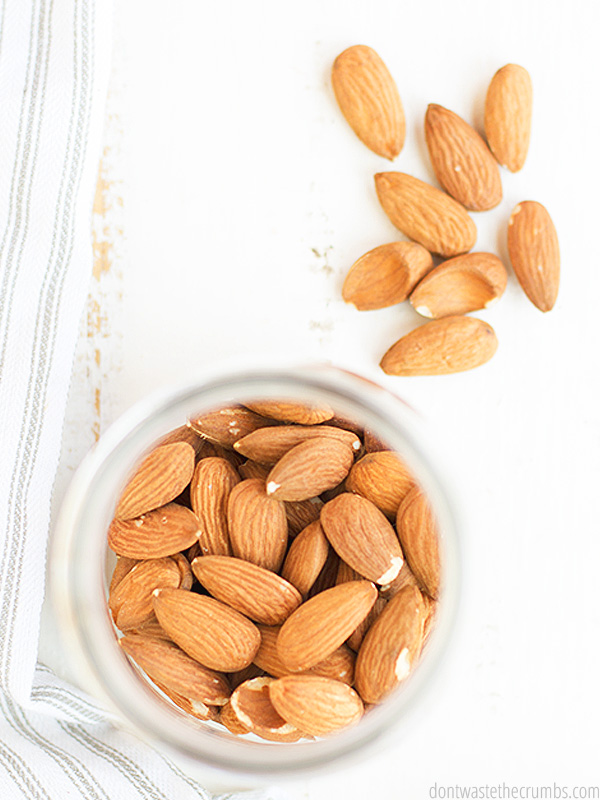
I really want to say that commercially made almond milk is the best of the non-dairy milk alternatives available. My friends drink it, my dad drinks it, and I was buying it regularly until the end of last year when I started using kefir in my smoothies instead!
Unfortunately, commercial almond milk looks no different than many other non-dairy kinds of milk:
- Coconut milk contained synthetic vitamins, minerals, and carrageenan. Oh, and it is EXTREMELY expensive.
- Hemp milk contained synthetic vitamins, minerals, and carrageenan. Although less than coconut milk, it’s still too rich for my blood.
- Cashew milk likely has unhealthy canola oil added to help with the consistency, in addition to synthetic vitamins and minerals. It costs more than hemp milk too, so it’s definitely not a frugal option.
- Rice milk, like the others, contains synthetic vitamins and minerals too. It may contain a lot of sugar as well, and the price is marked up by nearly 300%.
- Peanut milk isn’t widely available on the commercial market, which is probably a good thing. If you do find a container on the shelf, be wary: it appears that peanut milk is mainly produced in China (which doesn’t have the same standards as the U.S. and isn’t inspected well (if at all) upon import).
Do you see the pattern here?
- fake, synthetic vitamins (which our bodies don’t recognize nor know how to process)
- carrageenan (a known toxin that causes inflammation in the body)
- unnecessary additives (oils, sweeteners)
Almond milk is just the same. Although unsweetened, this brand contains carrageenan and four artificial vitamins. This brand is organic, and you’d expect it to be better, but it too has carrageenan and artificial vitamins. In fact, the only leading brand that DIDN’T have carrageenan is this one, but there are seven synthetic vitamins and minerals to make up for that.
Trader Joe’s carries a few brands of almond milk for $2 or less per 32oz container. That’s way better than any of the prices on Amazon, but there’s no guarantee that any of the brands at TJ’s don’t contain the same dangerous additives. The only way to avoid the toxins is to make them yourself.
Healthy Homemade Almond Milk
The process for making homemade almond milk is very much like other non-dairy milks with one big exception – straining is a must. Almonds will not completely grind up in the blender, even if they’re soaked, so you must strain out the larger pieces to achieve smooth, chunk-less milk.
The resulting almond meal can be dried (in an oven or dehydrator) and used in homemade granola bars, muffins, oatmeal, or almond hummus! It will add an almond flavor without having to actually use whole almonds.
Ingredients for Homemade Almond Milk
- almonds
- filtered water

How to Make Almond Milk at Home
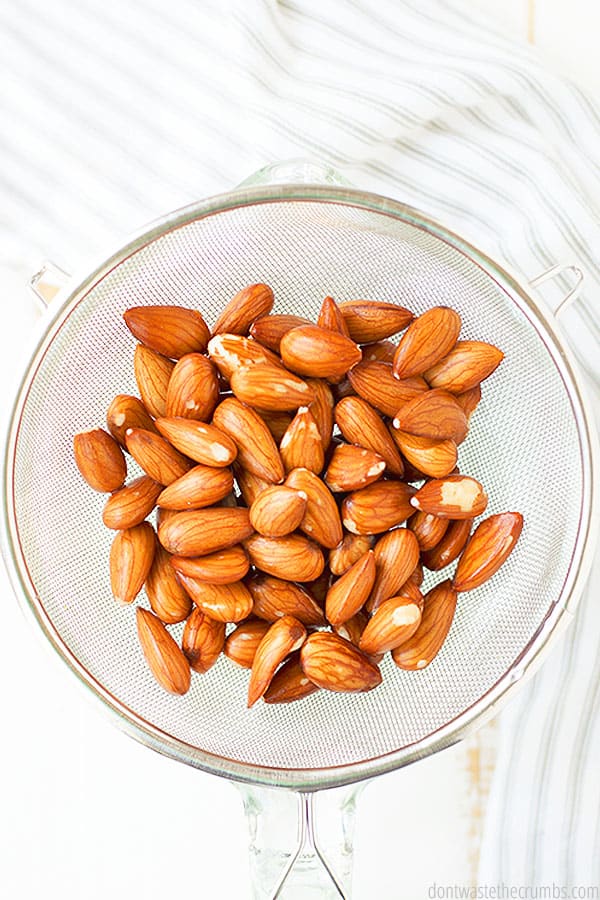
Step 1. Measure and place almonds into a large bowl or container and cover it with filtered water. Allow to soak overnight. This softens the nut considerably and makes it easier to blend, leaving fewer particles of nut in the finished milk (plus you get some of the benefits of soaking nuts too!).
Step 2. Drain nuts and place in a blender. Add 4 cups of filtered water and blend until smooth, approximately 1 minute. A second blend may be necessary since almonds are a tough nut and are hard to completely grind.
Step 3. Strain through a fine mesh strainer or nut milk bag. The pulp is great in homemade granola bars!
Step 4. Store milk in the refrigerator and enjoy cold.
FAQs for Homemade Almond Milk
How long will homemade almond milk last?
This homemade almond milk will last for up to 4 to 5 days in the fridge.
Why is my homemade almond milk bitter?
If your almond milk tastes bitter, the nuts are to blame. Nuts go bad faster than we think!
Is it worth it to make your own almond milk?
Yes! This milk only has TWO ingredients and is healthy. When you make your own almond milk, you will also get a creamy and richer flavor.
Recipe Notes
- For two cups: 1/2 cup almonds, 2 cups water
- For one cup: 1/4 cup almonds, 1 cup water
- Add additional water if you prefer thinner milk, or create vanilla almond milk by adding 1 teaspoon of vanilla extract.
- You can even mimic the specialty kinds of milk by combining almond and coconut milk together.
More Dairy-Free Milk Recipes

$50 Weekly Meal Plan
Sign up to get instant access to my $50 Weekly Meal Plan, complete with recipes and shopping list!Watch How to Make Homemade Almond Milk
Homemade Almond Milk
This homemade almond milk is one of the best dairy alternatives. It’s healthier and less expensive than store-bought, and it’s super easy to make! Vegan, dairy-free, and plant-based, too!
- Yield: 4 cups 1x
- Category: Beverages
- Method: No Cook
- Cuisine: American
Instructions
- Measure almonds into a container and cover it with filtered water. Allow to soak overnight. This softens the nut considerably and makes it easier to blend, leaving fewer particles of nut in the finished milk (plus you get some of the benefits of soaking nuts too!).
- Drain nuts and place in a blender. Add 4 cups of filtered water and blend until smooth, approximately 1 minute. A second blend may be necessary since almonds are a tough nut and are hard to completely grind.
- Strain through a fine mesh strainer or nut milk bag. The pulp is great in Homemade Granola Bars!
- Store milk in the refrigerator and enjoy cold.
Notes
- For two cups: ½ cup almonds, 2 cups water
- For one cup: ¼ cup almonds, 1 cup water
Nutrition
- Calories: 137

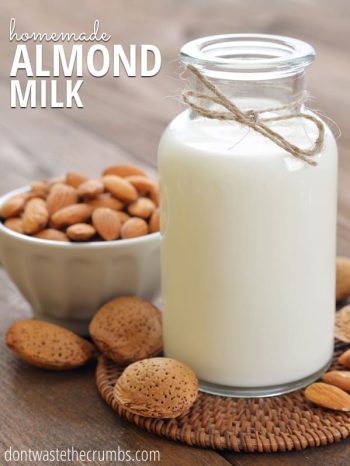
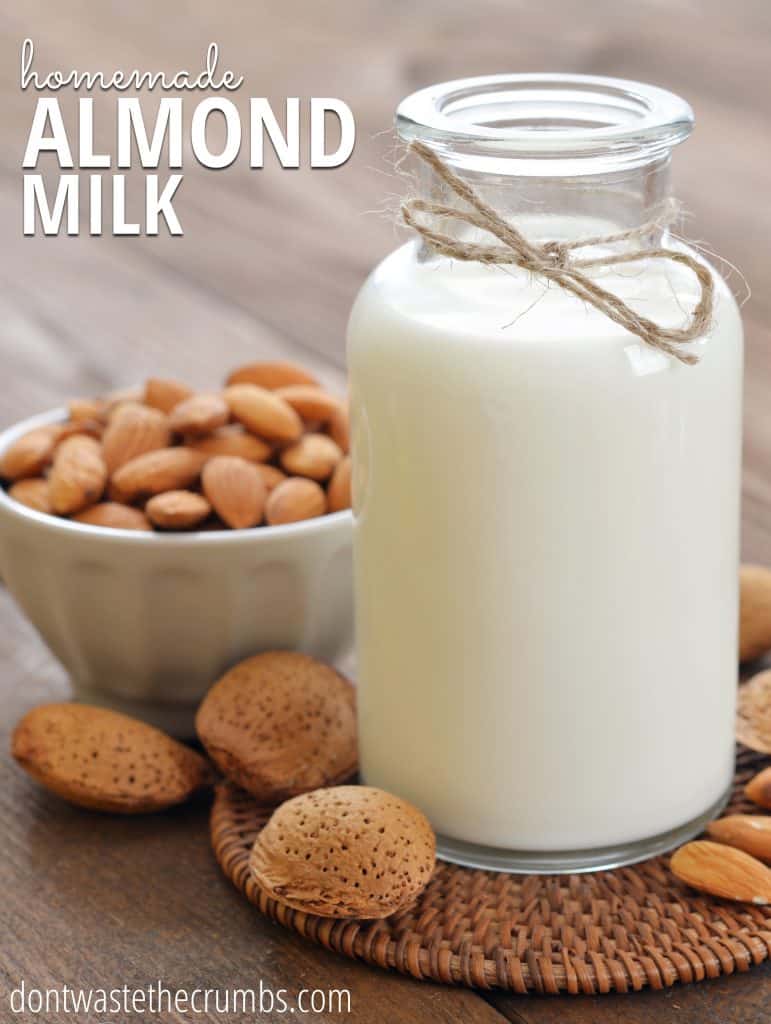
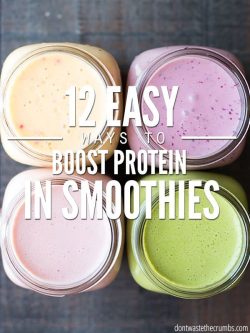
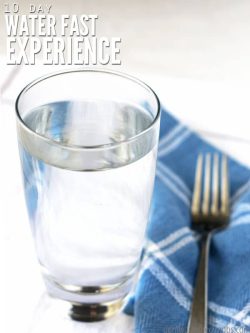
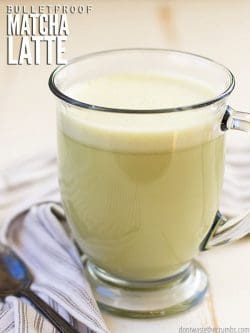
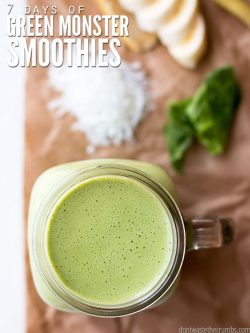

Thanks for this… I’m recently off dairy (feel so much better!) and have been drinking almond and coconut milk. I’ll try this recipe, but I use Califia Farms brand. It’s also carrageenan-free and non- GMO. I’ll definitely try the homemade version.
Hope you like it, Lisa!
Do you have a recipe for almond milk condensed milk? I’m completely dairy intolerant and unfortunately and strangely enough coconut milk (the easiest alternative) effects the same way too 🙁
Hi Misty!
Yes, we have a recipe for dairy free sweetened condensed milk. Although we used coconut milk in this recipe, you can try substituting it for almond milk (and switch out the coconut sugar for another sweetener if you need to). Let us know how it comes out for you. 🙂
https://dontwastethecrumbs.com/dairy-free-sweetened-condensed-milk/.
I know what you mean, Mary Jo! This is considered almond meal, and can be added to granola or dried and used for these thumbprint cookies: https://dontwastethecrumbs.com/healthy-thumbprint-cookies-recipe/
My mother would buy these large bags of whole, shelled walnuts and almonds from Costco. The first time l made almond milk, one or two almonds, swollen from an overnight soak, sprouted (absolutely delightful, if only l can plant them, but alas it’s too frigid here to grow them), the skins easily popped off, revealing the creamy white flesh. Making this milk is a bit messy and time consuming to strain the meal from the liquid. The milk itself is well…. Unsatisfying. I actually don’t like drinking dairy Milk, but am accustomed to the full fat or 2 percent variety. Almond milk is surprisingly rather low fat, thin, only a little bit thicker than skim milk and rather neutral in taste (l make mine unflavored and unsweetened). I was sorely disappointed! Soaking two or three walnut pieces and tossing it into the blender with the almonds made ALL the difference. The taste and texture was thicker, creamier and richer on par with cows milk. No thickeners or extra starches needed. Now This is the stuff I’d like to drink and eat cold cereal with! It was absolutely delightful!
An alternative to expensive Almonds are most definitely soy beans. They contain both fat and protein. The resulting milk is substantial with a naturally richer mouth feel. It’s a little more work on the sense you have to boil the beans first but it’s totally worth it. It is her important to throughly wash and soak them as well of course.
Thanks for the tip on the walnuts! I hadn’t thought of that, but they do have more fat so it makes sense!
Do you have a recipe for making granola with the homemade almond milk? Sorry ahead of time if you have this posted, I am very new to your site and learning but loving what I have read already!
Hi Rebecca! Do you mean a recipe that has almond milk as an ingredient? Or a granola recipe that uses the leftover ground almond?
Two things…
1) I usually/frequently make almond milk from almond butter and water — quicker that way — but do also make it starting from soaked almonds. Either way, I “never” strain it.
2) The one exception — when I do strain it — is if I want to make almond milk plus almond yogurt. If I’m doing that, I’ll start with soaked almonds, filter it through a nut-milk bag, but don’t press/squeeze really hard, then put the pulp in a bowl with (if needed) enough of the milk or some plain water until it’s a “yogurt” consistency. Then, I’ll add 1-2 Tbsp of store-bought, unsweetened, live-cultures yogurt, stir to mix, then put it into my yogurt maker to incubate it 8-12 hr, then refrigerate it.
Wow – that’s great thinking JSC! I’ve also heard that adding a probiotic capsule + gelatin can make DF yogurt, but I haven’t tried that one yet!
I’ve been making almond milk for a couple of months now and we like it so much better then store ones. I’ve been wondering though, do you have the nutritional value of homemade vs store bought? I know their won’t be fake/synthetic vitamins, but what else is there? Do I just look up almond’s nutritional value and then “thin it out” to account for the water or is there something less (or more)…? Thanks for the help!
That’s what I would do Nathalie. If you know how much almonds you start with, and then how much pulp you have at the end, you can determine how much almonds and water you actually have in the batch and use that to find the nutritional info.